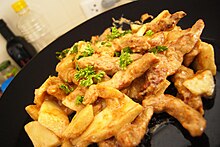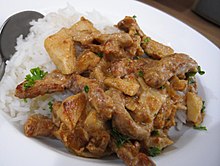Beef Stroganoff
 A plate of beef Stroganoff with fried potato and pickled vegetables | |
| Course | Main |
|---|---|
| Place of origin | Russian Empire |
| Region or state | Eastern Europe |
| Serving temperature | Hot |
| Main ingredients | Beef,smetana(sour cream) |
| Variations | (outside Russia): ChickenStroganoff, sausage Stroganoff, mushroom Stroganoff, shrimp Stroganoff, veal Stroganoff, pork Stroganoff |
Beef Stroganofforbeef Stroganov[a]is aRussian dishofsautéedpieces ofbeefin a sauce of mustard andsmetana(sour cream). From its origins in mid-19th-centuryTsarist Russia,it has become popular around the world, with considerable variation from the original recipe. Mushrooms are common in many variants.
History
[edit]The dish is named after one of the members of theStroganov family.[2][3][4][5]A legend attributes its invention to French cooks working for the family,[6]but several researchers point out that the recipe is a refined version of older Russian dishes.[3][4]InRussianthe dish is calledБефстро́гановfrom theFrenchBœuf Stroganoff.[7]

Elena Molokhovets's classic Russian cookbookA Gift to Young Housewivesgives the first known recipe forGovjadina po-strogonovski, s gorchitseju,"Beefà laStroganov, with mustard ", in its 1871 edition.[8][3][4]The recipe involves beefcubes(not strips) prepared in a dry marinade of salt and allspice, and then sautéed in butter. The sauce is a simplerouxmixed withprepared mustardandbroth,and finished with a small amount of sour cream: noonions,nomushroomsand no alcohol.
In 1891, the French chef Charles Brière, who was working in Saint Petersburg, submitted a recipe for beef Stroganoff to a competition sponsored by the French magazineL'Art culinaire.[4]This ledLarousse Gastronomiqueto assume that he was the inventor of this dish, but both the recipe and the name existed before then.

Another recipe, this one from 1909, adds onions andtomato sauce,and serves it with crisppotatostraws, which are considered the traditional side dish for beef Stroganoff in Russia.[8][9]The version given in the 1938Larousse Gastronomiqueincludes beefstrips,and onions, with either mustard or tomato paste optional.
After thefallofTsarist Russia,the recipe was popularly served in the hotels and restaurants ofChinabefore the start ofWorld War II.[10]RussianandChineseimmigrants, as well as US servicemen stationed inpre-Communist China,brought several variants of the dish to the United States, which may account for its popularity during the 1950s.[citation needed]It came to Hong Kong in the late fifties,[11]with Russian restaurants and hotels serving the dish withricebut not sour cream.[citation needed]
In 1960s United States, several manufacturers introduced dehydrated beef stroganoff mixes, which were mixed with cooked beef and sour cream.[12][13]It was also available freeze-dried for campers.[14]
Around the world
[edit]This sectionneeds additional citations forverification.(May 2020) |
Beef Stroganoff preparation varies significantly not only based on geography, but based on other factors as well, such as the cut of meat and seasonings selected. Meat for the dish can be cut in different ways and is sometimes diced, cubed, or cut into strips. Some variations include mushrooms and onions or other vegetables and varied seasonings such as sugar, salt, black pepper, and bottledmarinades(especiallyWorcestershire sauce) and rubs.[15]


In the version often prepared in the United States today in restaurants and hotels, it consists of strips of beef filet with a mushroom, onion, andsour creamsauce, and is served over rice or noodles.[16]Today, the dish is generally served over wide or twistedegg noodlesin the United States. British pubs usually serve a version of the dish with a creamy white wine sauce, whereas more "authentic" versions are often red stews with a scoop of sour cream separately served on top.[citation needed]

Larousse Gastronomiquelists Stroganoff as a cream,paprika,veal stock and white wine recipe. The Brazilian variant includes diced beef or strips of beef with tomato sauce, onions, mushrooms and heavy cream. Brazilians also prepare Stroganoff with chicken or even shrimp instead of beef. It is commonly served with a side of shoe-string potatoes and white rice. In Portuguese it is calledStrogonofforEstrogonofe.
Stroganoff is also popular inNordic countries.In Sweden, a common variant iskorv Stroganoff(lit. 'sausage Stroganoff'), which uses the localfalukorvsausageas a substitute for the beef. In Finland, the dish is calledmakkara-stroganoff,makkara meaning any kind of sausage. Beef Stroganoff is, however, also a common dish. Dicedbrined picklesare also a normal ingredient in Finnish Stroganoff.
Stroganoff's popularity extends to Japan, where it is most commonly served with white rice, or white rice seasoned with parsley and butter. Its popularity increased dramatically with the introduction of "instant sauce cubes" fromS&B Foods.These are cubes with dried seasoning and thickening agents that can be added to water, onion, beef, and mushrooms to make a Stroganoff-style sauce. Additionally, Japanese home recipes for Stroganoff frequently call for ingredients that are outside of Russian tradition, such as small amounts of soy sauce.[citation needed]
See also
[edit]- List of beef dishes
- List of foods named after people
- List of Russian dishes
- CountAlexander Stroganov
Notes
[edit]- ^UK:/ˈstrɒɡənɒf/,US:/ˈstrɔːɡənɔːf,ˈstroʊɡ-/;Russian:бефстроганов,romanized:befstroganov,[1]IPA:[bʲɪfˈstroɡənəf]
References
[edit]- ^В. В. Лопатин, ed. (1999).Бефстроганов.Русский орфографический словарь.Москва: Азбуковник.[V. V. Lopatin, ed. (1999). "Beef Stroganov".Russian Orthographic Dictionary(in Russian). Moscow: Azbukovnik.]
- ^Вильям Похлёбкин (2002).Кулинарный словарь.Москва: Центрполиграф.ISBN5-227-00460-9.[William Pokhlyobkin(2002).Culinary Dictionary(in Russian). Moscow: Centrpoligraph.]
- ^abcAnne Volokh, Mavis Manus,The Art of Russian Cuisine.New York: Macmillan, 1983, p. 266,ISBN978-0-02622090-3
- ^abcdOlga Syutin; Pavel Syutkin (2015).CCCP Cook Book: True Stories of Soviet Cuisine.Fuel Publishing.ISBN978-0-99319111-4.
- ^"Beef stroganoff".bridgetomoscow.Retrieved2023-03-19.
- ^Jennifer Eremeeva (2019-02-20)."The Definitive Beef Stroganoff".TheMoscow Times.
- ^С, Блейк (2014).Строгановы. Самые богатые в России(in Russian). Рипол Классик.ISBN978-5-386-06945-2.
- ^abЕлена Молоховец (1871).Подарок молодым хозяйкам[A Gift to Young Housewives] (in Russian). Санкт-Петербург.
{{cite book}}:CS1 maint: location missing publisher (link),English translation:Joyce Stetson Toomre, ed. (1998).Classic Russian Cooking: Elena Molokhovets' a Gift to Young Housewives.Indiana University Press.ISBN978-0-25321210-8.The first edition (1861) did not include Beef Stroganoff, which first appeared in the 1871 edition (Volokh, 1983; Syutkin, 2015). The 1912 recipe mentioned by Toomre is in Alekandrova-Ignatieva, 1912, p. 611, but was also published in earlier editions. - ^Александрова-Игнатьева, Пелагея Павловна (1909).Практические основы кулинарного искусства(in Russian). Санкт-Петербург.
{{cite book}}:CS1 maint: location missing publisher (link) - ^Frank Dorn,The Dorn Cookbook.Chicago: Henry Regnery Co., 1953, pp. 126–27
- ^Christopher Dewolf (4 October 2017)."Why Do Hong Kong Restaurants Serve Borscht? The Overlooked History of Russian Hong Kong".Zolima CityMag.Retrieved16 July2020.
- ^Ruth Lundgren Williamson, "The Companionway" (column),Motor Boating,June 1968,p. 151
- ^Broadcasting70,unknown issue,p. 68
- ^Richard D. Taber,Coniferous Forests of the Northern Rocky Mountains,p. 384
- ^"The Food Lab: Rethinking Beef Stroganoff".Serious Eats.Retrieved15 January2018.
- ^Рецепт: Бефстроганов классический на.Russian Food.RetrievedDec 8,2022.
External links
[edit] Media related toBeef Stroganoffat Wikimedia Commons
Media related toBeef Stroganoffat Wikimedia Commons- TheFood Timelinehas some quotes about the dish.
